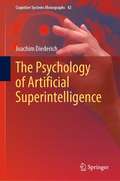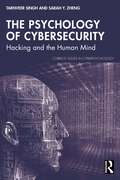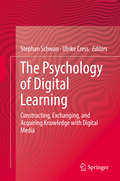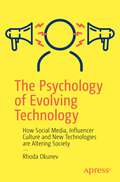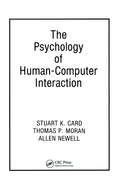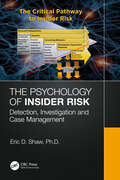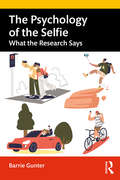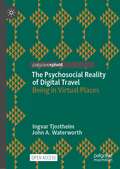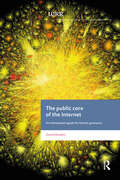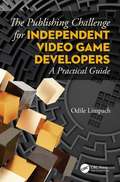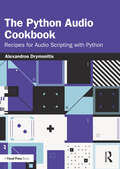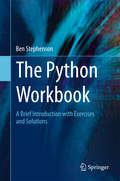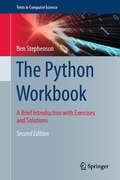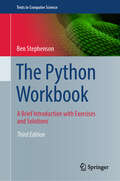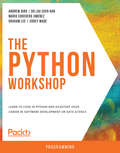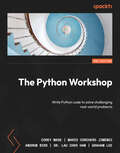- Table View
- List View
The Psychology of Artificial Superintelligence (Cognitive Systems Monographs #42)
by Joachim DiederichThis book explores the psychological impact of advanced forms of artificial intelligence. How will it be to live with a superior intelligence? How will the exposure to highly developed artificial intelligence (AI) systems change human well-being? With a review of recent advancements in brain–computer interfaces, military AI, Explainable AI (XAI) and digital clones as a foundation, the experience of living with a hyperintelligence is discussed from the viewpoint of a clinical psychologist. The theory of universal solicitation is introduced, i.e. the demand character of a technology that wants to be used in all aspects of life. With a focus on human experience, and to a lesser extent on technology, the book is written for a general readership with an interest in psychology, technology and the future of our human condition. With its unique focus on psychological topics, the book offers contributions to a discussion on the future of human life beyond purely technological considerations.
The Psychology of Cybersecurity: Hacking and the Human Mind (Current Issues in Cyberpsychology)
by Tarnveer Singh Sarah Y. ZhengThis book takes a fresh look at the underappreciated role of human psychology in cybersecurity and information technology management. It discusses the latest insights from practice and scholarly work on the role of cognitive bias and human factors in critical decisions that could affect the lives of many people.Written by an experienced chief information security officer (CISO) and an academic with over two decades of lived experience dealing with cybersecurity risks, this book considers the psychological drivers and pitfalls of the four key personas in cybersecurity – from hackers and defenders, to targeted individuals and organisational leaders. It bridges state-of-the-art research findings with real-world examples and case studies to show how understanding the psychological factors in cybersecurity can help people protect themselves and their organisations better.Full of advice on security best practices that consider the human element of cybersecurity, this book will be of great interest to professionals and managers in the cybersecurity domain, information technology, and governance and risk management. It will also be relevant to students and those aspiring to grow in this field.
The Psychology of Digital Learning
by Ulrike Cress Stephan SchwanThis book provides an overview of the state-of-the art of psychological research on learning and knowledge exchange with digital media, based on a comprehensive research program that was realized at the Leibniz-Institut f#65533;r Wissensmedien(IWM) during the last decade. The dramatic rise of new tools and technologies, including both hardware devices like smartphones, tablets, multitouch-tables, or stereoscopic screens as well as software environments like Google, Wikipedia, Facebook, Twitter or MOOCs - has fundamentally reshaped teaching, learning, and knowledge exchange. The authors describe an area of digital learning in light of these recent technological developments, specify the relevant theoretical approaches, summarize the main research results from the lab, and discuss their theoretical and practical implications.
The Psychology of Everyday Things
by Donald A. NormanEven the smartest among us can feel inept as we fail to figure our which light switch or oven burner to turn on, or whether to push, pull, or slide a door. The fault, argues this fascinating, ingenious—even liberating—book, lies not in ourselves, but in product design that ignores the needs of users and the principles of cognitive psychology. The problems range from ambiguous and hidden controls to arbitrary relationships between controls and functions, coupled with a lack of feedback or other assistance and unreasonable demands on memorization. The book presents examples aplenty—among them, the VCR, computer, and office telephone, all models of how not to design for people.But good, usable design is possible. The rules are simple: make things visible, exploit natural relationships that couple function and control, and make intelligent use of constraints. The goal: guide the user effortlessly to the right action on the right control at the right time. But the designer must care.
The Psychology of Evolving Technology: How Social Media, Influencer Culture and New Technologies are Altering Society
by Rhoda OkunevTechnological innovations have advanced at an incredible speed since the introduction of the computer that it has altered the fabric of our society. The possession of computers, smart-devices, along with social media, texting and video games, is now an intimate part of the structure of our culture. This book is a framework to start a conversation on how technology is changing our lifestyles and transforming our world. There is now an entire generation that has been using technology through the most delicate developmental time in their lives. This book presents how to look at the cognitive and psychosocial developmental stages and what are the age-appropriate milestones and factsheet of behaviors at different ages. It provides insight into the strength and vulnerable characteristics at each stage and the prevalence of some negative conditions in our society. You will gain a perspective of the encouraging and challenging aspects of computer learning, smart devices, and how to start and keep the conversation going from infancy to adulthood in order to keep and maintain your virtues and ways to circumvent unfavorable consequences. In short, The Psychology of Evolving Technology looks at how cutting-edge and revolutionary high technologies have disrupted our society through its many luxuries and conveniences and how it has altered the outlook of our values, privileges, and expectations. What You'll LearnDetermine what adjustments should be made to regulate new innovations to allow them to succeed See how development stages in a child now interact with technologyReview how social media and influencer culture are changing the way we see ourselves in society Who This Book Is For All readers curious about the effect of technology on individuals, growing children, and the fabric of society
The Psychology of Human-Computer Interaction
by Stuart K. Card, Thomas P. Moran and Allen NewellDefines the psychology of human-computer interaction, showing how to span the gap between science & application. Studies the behavior of users in interacting with computer systems.
The Psychology of Insider Risk: Detection, Investigation and Case Management
by Eric ShawClinical psychologist and former intelligence officer Eric D. Shaw brings over 30 years of psychological consultation experience to the national security community, corporate investigations and law enforcement to this work on insider risk. After a career in counterterrorism, Dr. Shaw spent the last 20 years concentrating on insiders—employees who commit espionage, sabotage, intellectual property theft, present risks of harm to self and others, and other workplace risks, especially those influenced by mental health conditions. Dr. Shaw is the author of the Critical Pathway to Insider Risk (CPIR) which addresses the characteristics, experiences and connections at-risk employees bring to our organizations, the stressors that trigger higher levels of risk, the concerning behaviors that signal this risk has increased and the action or inaction by organizations that escalate insider risk. The CPIR also examines what these employees look like when they have broken bad and the personal characteristics, resources and support that can mitigate these risks. Dr. Shaw also examines specific risk accelerators like subject disgruntlement, personality disorders and problematic organizational responses that can escalate the speed and intensity of insider risks. The investigative applications, strengths and weaknesses of the CPIR are also considered. This work also describes the behavioral science tools deployed in insider investigations, especially those designed to locate and understand persons at-risk and help organizations intervene to avoid escalation or manage potential damage. Case examples are drawn from intelligence community, corporate and law enforcement investigations. Specific insider cases where the use of behavioral science tools is described in detail include leaks, anonymous threats, erotomania, hacking, violence risk, mass destruction threats and espionage. The work closes with consideration of the many current and future challenges insider risk professionals face. These include the challenge of recognizing suicidal ideation as a gateway to other forms of insider risk, understanding when subject therapy will, and will not reduce risk, deciphering belief in conspiracy theory from significant extremist risk, appreciating insider threats to our elections and the unique challenges posed when the insider is a leader.
The Psychology of the Internet
by Patricia WallaceThis timely volume explores the psychological aspects of cyberspace, a virtual world in which people from around the globe are acting and interacting in many new, unusual, and occasionally alarming ways. Drawing on research in the social sciences, communications, business, and other fields, Patricia Wallace examines how the online environment can influence the way we behave, sometimes for the better, sometimes not. Our own online behavior then becomes part of the Internet's psychological environment for others, creating opportunities for shaping the way this new territory for human interaction is unfolding. Since the Internet--and our experience within it--is still young, we have a rare window of opportunity to influence the course of its development. With a new preface that incorporates many of the changes online and in the field since the hardcover edition was published, the paperback edition of The Psychology of the Internet includes the latest coverage of e-commerce, workplace surveillance and datamining, all areas of recent intense public concern. Patricia M. Wallace is Executive Director of the Center for Knowledge and Information Management at the Robert H. Smith School of Business, University of Maryland. She is author of an interactive psychology CD-ROM called PRISM and of the textbook Introduction to Psychology, Fourth Edition (with Jeffrey Goldstein). Dr. Wallace is also the principal investigator on grants from the Annenberg Projects/Corporation for Public Broadcasting dealing with language learning through CD-ROMs and the Internet.
The Psychology of the Selfie: What the Research Says
by Barrie GunterThe Psychology of the Selfie provides a comprehensive overview and analysis of research on the significance of selfies, offering insights into the topic from a psychological perspective and examining important issues such as body image, self-objectification, mental health and psychological benefits. Selfies are a worldwide phenomenon. Although dismissed by critics as a sign of self-absorbed narcissism, they are also a social currency that maintains and reinforces friendships, a feedback loop for self-identity affirmation, a promotional tool for gaining social influence, and a method for preserving memories of life events. In this book, Barrie Gunter expertly explores the psychological underpinnings of the contemporary global phenomenon of "selfies", from the historical roots and meteoric rise due to technical advancements, to the different personality types of selfie-takers, to social relationships, to group and personal identity. Looking at both the psychological nature and impact of selfies, this book reviews different psychological outcomes for selfie-takers, both positive and negative, and the growth in psychological and physical problems that can sometimes arise. Presenting a comprehensive analysis specifically of selfie behaviour, this book is an essential reference for students and researchers in communications and media, journalism, information studies, psychology and sociology, as well as anyone with a general interest in the phenomenon.
The Psychosocial Reality of Digital Travel: Being in Virtual Places
by Ingvar Tjostheim John A. WaterworthThis open access book takes a fresh look at the nature of the digital travel experience, at a time when more and more people are engaged in online social interaction, games, and other virtual experiences essentially involving online visits to other places. It examines whether these experiences can seem real to the virtual traveller and, if so, under what conditions and on what grounds. The book unpacks philosophical theories relevant to the feeling of being somewhere, emphasising the importance of perception and being-in-the-world. Notions of place are outlined, based on work in tourism studies, human geography, and other applied social fields, with an aim to investigate how and when different experiences of place arise for the traveller and how these relate to telepresence – the sense of being there in another place through digital media. Findings from recent empirical studies of digital travel are presented, including a survey from which the characteristics of “digital travellers” are identified. A review of selected interactive design trends and possibilities leads to the conclusion, which draws these strands together and looks to the future of this topical and expanding field.
The Public Core of the Internet: An international Agenda for Internet Governance (WRR Rapporten)
by Dennis BroedersThe growth and health of our digital economies and societies depend on the core protocols and infrastructure of the Internet. This technical and logical substructure of our digital existence is now in need of protection against unwarranted interference in order to sustain the growth and the integrity of the global Internet. The Internet's key protocols and infrastructure can be considered a global public good that provides benefits to everyone in the world. Countering the growing state interference with this 'public core of the Internet' requires a new international agenda for Internet governance that departs from the notion of a global public good. Core ingredients of this strategy are: - To establish and disseminate an international norm stipulating that the Internet's public core - its main protocols and infrastructure- should be considered a neutral zone, safeguarded against unwarranted intervention by governments. - To advocate efforts to clearly differentiate at the national and international level between Internet security (security of the Internet infrastructure) and national security (security through the Internet). - To broaden the arena for cyber diplomacy to include new coalitions of states (including the so called 'swing states') and private companies, including the large Internet companies as well as Internet intermediaries such as Internet Service Providers.
The Public Library in the Bibliographic Network (Routledge Library Editions: Library and Information Science #69)
by Betty TurockThis book, first published in 1986, focuses on valuable information to all public library professionals who have questions about their participation in bibliographic networks. Contributors provide insights into both the benefits and the costs of networking by libraries of varying sizes and geographic locations. The actual uses of networks, their costs (including initial and ongoing expenses), and staffing needs are clearly explained.
The Public Space of Social Media: Connected Cultures of the Network Society (Routledge Studies in New Media and Cyberculture)
by Therese TierneySocial media is restructuring urban practices–through ad-hoc experimentation, commercial software development, and communities of participation. This book is the first to consider how practices contained within social media are situated within a larger genealogy of public space, including theories of communal identity, civitas and democracy, the fete, and self-expression. Through empirical research, the actual social practices of participants of networked publics are described and analyzed. Documenting how online counterpublics use the Internet to transmit classified photos, mobilize activists, and challenge the status quo, Tierney argues that online activities do not stop in online conversations; they are physically grounded through mobile GPS coordinates which are then transformed into activities in physical space—the street, the plaza, the places where people have traditionally gathered to demonstrate and express their opinions publicly.
The Public and Their Platforms: Public Sociology in an Era of Social Media (Public Sociology)
by Mark Carrigan Lambros FatsisAvailable Open Access digitally under CC-BY-NC-ND licence. As social media is increasingly becoming a standard feature of sociological practice, this timely book rethinks the role of these mediums in public sociology and what they can contribute to the discipline in the post-COVID world. It reconsiders the history and current conceptualizations of what sociology is, and analyzes what kinds of social life emerge in and through the interactions between ‘intellectuals’, ‘publics’ and ‘platforms’ of communication. Cutting across multiple disciplines, this pioneering work envisions a new kind of public sociology that brings together the digital and the physical to create public spaces where critical scholarship and active civic engagement can meet in a mutually reinforcing way.
The Publishing Challenge for Independent Video game Developers: A Practical Guide
by Odile LimpachProfessor Odile Limpach gives independent developers everything they need to succeed in the world of video game publishing. The Publishing Challenge for Independent Video Game Developers: A Practical Guide defines what game publishing means for the indie developer and offers a concise framework to tackle the decision of whether to self-publish or not. Furthermore, the text establishes a catalogue of current known publishers with some salient characteristics and offers a list of useful publishing tools. Along with showcasing testimonials from several young and seasoned developers on their experiences with publishing and partners and recommendations from renown experts of the industry, this book offers tools, platforms, and guides to game publishing. Key features: Provides a broad overview of the game publishing market Explores criteria for choosing between a publishing partner or self-publishing Offers case studies and testimonials from indie game developers and publishers about the process. Professor Odile Limpach teaches economics and entrepreneurship at the Cologne Game Lab, TH Köln (Technical University of Cologne). She is also co-founder of the Acceleration Program SpielFabrique 360° and works as a Strategic Consultant for games and serious game projects. Between 2007 and 2014, she was the managing director of the German entertainment software studio Ubisoft Blue Byte. Before, she was the managing director of Ubisoft GmbH. She graduated from business school Institut Commercial de Nancy in France and completed her MBA in the United States. Odile Limpach is also involved as a volunteer in the areas of vocational training and acts as a German partner for Games for Change Europe. Furthermore, she acts as an advisor (Conseiller du Commerce Extérieur) for the French Ministry for International Business Development.
The Pyramid of Game Design: Designing, Producing and Launching Service Games
by Nicholas LovellGame design is changing. The emergence of service games on PC, mobile and console has created new expectations amongst consumers and requires new techniques from game makers. <P><P>In The Pyramid of Game Design, Nicholas Lovell identifies and explains the frameworks and techniques you need to deliver fun, profitable games. Using examples of games ranging from modern free-to-play titles to the earliest arcade games, via PC strategy and traditional boxed titles, Lovell shows how game development has evolved, and provides game makers with the tools to evolve with it. <P><P>Lovell shows how service games require all the skills of product game development, and more. He provides a toolset for game makers of all varieties to create fun, profitable games. Filled with practical advice, memorable anecdotes and a wealth of game knowledge, the Pyramid of Game Design is a must-read for all game developers. <P><P>Key Features <li>Harness the Base, Retention and Superfan Layers to create a powerful Core Loop. <li>Design the player Session to keep players playing while being respectful of their time. <li>Accept that there are few fixed rules: just trade-offs with consequences. <li>Adopt Agile and Lean techniques to "learn what you need you learn" quickly. <li>Use analytics, paired with design skills and player feedback, to improve the fun, engagement and profitability of your games. <li>Adapt your marketing techniques to the reality of the service game era. <li>Consider the ethics of game design in a rapidly changing world.
The Python Apprentice
by Austin Bingham Robert SmallshireLearn the Python skills and culture you need to become a productive member of any Python project. About This Book • Taking a practical approach to studying Python • A clear appreciation of the sequence-oriented parts of Python • Emphasis on the way in which Python code is structured • Learn how to produce bug-free code by using testing tools Who This Book Is For The Python Apprentice is for anyone who wants to start building, creating and contributing towards a Python project. No previous knowledge of Python is required, although at least some familiarity with programming in another language is helpful. What You Will Learn • Learn the language of Python itself • Get a start on the Python standard library • Learn how to integrate 3rd party libraries • Develop libraries on your own • Become familiar with the basics of Python testing In Detail Experienced programmers want to know how to enhance their craft and we want to help them start as apprentices with Python. We know that before mastering Python you need to learn the culture and the tools to become a productive member of any Python project. Our goal with this book is to give you a practical and thorough introduction to Python programming, providing you with the insight and technical craftsmanship you need to be a productive member of any Python project. Python is a big language, and it's not our intention with this book to cover everything there is to know. We just want to make sure that you, as the developer, know the tools, basic idioms and of course the ins and outs of the language, the standard library and other modules to be able to jump into most projects. Style and approach We introduce topics gently and then revisit them on multiple occasions to add the depth required to support your progression as a Python developer. We've worked hard to structure the syllabus to avoid forward references. On only a few occasions do we require you to accept techniques on trust, before explaining them later; where we do, it's to deliberately establish good habits.
The Python Audio Cookbook: Recipes for Audio Scripting with Python
by Alexandros DrymonitisThe Python Audio Cookbook offers an introduction to Python for sound and multimedia applications, with chapters that cover writing your first Python programs, controlling Pyo with physical computing, and writing your own GUI, among many other topics. Guiding the reader through a variety of audio synthesis techniques, the book empowers readers to combine their projects with popular platforms, from the Arduino to Twitter, and state-of-the-art practices such as AI. The Python Audio Cookbook balances accessible explanations for theoretical concepts, including Python syntax, audio processing and machine learning, with practical applications. This book is an essential introductory guide to Python for sound and multimedia practitioners, as well as programmers interested in audio applications.
The Python Quick Syntax Reference
by Gregory WaltersThe Python Quick Syntax Reference is the "go to" book that contains an easy to read and useguide to Python programming and development. This condensed code and syntaxreference presents the Python language in a well-organized format designed tobe used time and again. You won't find jargon, bloated samples, case studies, or history of Hello Worldand computer theory in this handy reference. This Python syntax reference ispacked with useful information and is a must-have for any Python developer. What you'll learn Variables, strings, lists, dictionaries andconditional statements are and how to use them Some of the standard libraries and what they cando to help you How to write your own functions How to write your first Python program based onterminal Input and Output How to use the Python Interactive Shell How to use classes in your Python programs Who this book is for The Python Quick Syntax Reference is a great pocket reference guide for anyone wanting to program in Python, from the new user to the experienced programmer. Table of Contents Chapter 1: Hello Python Chapter 2: Variables Chapter 3: Operators Chapter 4: Strings Chapter 5: Conditional Statements and Loops Chapter 6: Data Structures Chapter 7: Keywords Chapter 8: Functions Chapter 9: Libraries Chapter 10: Classes
The Python Workbook: A Brief Introduction with Exercises and Solutions
by Ben StephensonWhile other textbooks devote their pages to explaining introductory programming concepts, The Python Workbook focuses exclusively on exercises, following the philosophy that computer programming is a skill best learned through experience and practice. Designed to support and encourage hands-on learning about programming, this student-friendly work contains 174 exercises, spanning a variety of academic disciplines and everyday situations. Solutions to selected exercises are also provided, supported by brief annotations that explain the technique used to solve the problem, or highlight specific points of Python syntax. No background knowledge is required to solve the exercises, beyond the material covered in a typical introductory Python programming course. Undergraduate students undergoing their first programming course and wishing to enhance their programming abilities will find the exercises and solutions provided in this book to be ideal for their needs.
The Python Workbook: A Brief Introduction with Exercises and Solutions (Texts in Computer Science)
by Ben StephensonThis student-friendly textbook encourages the development of programming skills through active practice by focusing on exercises that support hands-on learning. The Python Workbook provides a compendium of 186 exercises, spanning a variety of academic disciplines and everyday situations. Solutions to selected exercises are also provided, supported by brief annotations that explain the technique used to solve the problem, or highlight a specific point of Python syntax.This enhanced new edition has been thoroughly updated and expanded with additional exercises, along with concise introductions that outline the core concepts needed to solve them. The exercises and solutions require no prior background knowledge, beyond the material covered in a typical introductory Python programming course.Features: uses an accessible writing style and easy-to-follow structure; includes a mixture of classic exercises from the fields of computer science and mathematics, along with exercises that connect to other academic disciplines; presents the solutions to approximately half of the exercises; provides annotations alongside the solutions, which explain the approach taken to solve the problem and relevant aspects of Python syntax; offers a variety of exercises of different lengths and difficulties; contains exercises that encourage the development of programming skills using if statements, loops, basic functions, lists, dictionaries, files, and recursive functions.Undergraduate students enrolled in their first programming course and wishing to enhance their programming abilities will find the exercises and solutions provided in this book to be ideal for their needs.
The Python Workbook: A Brief Introduction with Exercises and Solutions (Texts in Computer Science)
by Ben StephensonThe Python Workbook is a student-friendly compendium of 212 exercises that span a variety of academic disciplines and everyday situations paired with concise introductions to the programming concepts needed to complete them. Accessible and easy to follow, the textbook encourages development of programming skills through active practice and hands-on learning. Thoroughly updated and expanded, this strong revised edition includes new sections on debugging, additional exercises in all chapters, and extensive revisions that reflect current practice, increase clarity, and ease comprehension. The exercises and solutions require no prior background knowledge, beyond the material covered in a typical introductory Python course. Topics and features: includes a mixture of classic exercises from the fields of computer science and mathematics, along with exercises that connect to other academic disciplines presents the solutions to approximately half of the exercises provides annotations alongside the solutions, explaining the approach taken to solve the problem and relevant aspects of Python syntax contains exercises that encourage the development of programming skills using if statements, loops, functions, lists, dictionaries, files, and recursion examines common errors and how to correct them offers a variety of exercises of different lengths and difficulties Undergraduate students enrolled in their first programming course will find this book ideal for their needs. Their programming and debugging skills will be enhanced by reading its chapters, completing its exercises, and studying the provided solutions.
The Python Workshop: A Practical, No-Nonsense Introduction to Python Development
by Andrew Bird Graham Lee Dr Lau Han Mario Corchero Jimenez Corey WadeCut through the noise and get real results with a step-by-step approach to learning Python 3.X programming Key Features Experimental projects showcasing the implementation of high-performance deep learning models with Keras. Use-cases across reinforcement learning, natural language processing, GANs and computer vision. Build strong fundamentals of Keras in the area of deep learning and artificial intelligence Book Description You already know you want to learn Python, and a smarter way to learn Python 3 is to learn by doing. The Python Workshop focuses on building up your practical skills so that you can work towards building up your machine learning skills as a data scientist, write scripts that help automate your life and save you time, or even create your own games and desktop applications. You'll learn from real examples that lead to real results. Throughout The Python Workshop, you'll take an engaging step-by-step approach to understanding Python. You won't have to sit through any unnecessary theory. If you're short on time you can jump into a single exercise each day or spend an entire weekend learning about Python scripting. It's your choice. Learning on your terms, you'll build up and reinforce key skills in a way that feels rewarding. Every physical copy of The Python Workshop unlocks access to the interactive edition. With videos detailing all exercises and activities, you'll always have a guided solution. You can also benchmark yourself against assessments, track progress, and receive free content updates. You'll even earn a secure credential that you can share and verify online upon completion. It's a premium learning experience that's included with your printed copy. To redeem, follow the instructions located at the start of your Python book. Fast-paced and direct, The Python Workshop is the ideal companion for Python beginners. You'll build and iterate on your code like a software developer, learning along the way. This process means that you'll find that your new skills stick, embedded as best practice. A solid foundation for the years ahead. What you will learn Learn how to write clean and concise code with Python 3 Understand classes and object-oriented programming Tackle entry-level data science and create engaging visualizations Use Python to create responsive, modern web applications Automate essential day-to-day tasks with Python scripts Get started with predictive Python machine learning Who this book is for This book is designed for professionals, students, and hobbyists who want to learn Python and apply it to solve challenging real-world problems. Although this is a beginner's book, it will help if you already know standard programming topics, such as variables, if-else statements, and functions. Experience with another object-oriented program is beneficial, but not mandatory.
The Python Workshop: Write Python code to solve challenging real-world problems, 2nd Edition
by Andrew Bird Graham Lee Mario Corchero Jimenez Corey Wade Dr. Lau HanGain proficiency, productivity, and power by working on projects and kick-starting your career in Python with this comprehensive, hands-on guide.Key FeaturesUnderstand and utilize Python syntax, objects, methods, and best practicesExplore Python's many features and libraries through real-world problems and big dataUse your newly acquired Python skills in machine learning as well as web and software developmentBook DescriptionPython is among the most popular programming languages in the world. It's ideal for beginners because it's easy to read and write, and for developers, because it's widely available with a strong support community, extensive documentation, and phenomenal libraries – both built-in and user-contributed.This project-based course has been designed by a team of expert authors to get you up and running with Python. You'll work though engaging projects that'll enable you to leverage your newfound Python skills efficiently in technical jobs, personal projects, and job interviews. The book will help you gain an edge in data science, web development, and software development, preparing you to tackle real-world challenges in Python and pursue advanced topics on your own. Throughout the chapters, each component has been explicitly designed to engage and stimulate different parts of the brain so that you can retain and apply what you learn in the practical context with maximum impact.By completing the course from start to finish, you'll walk away feeling capable of tackling any real-world Python development problem.What you will learnWrite efficient and concise functions using core Python methods and librariesBuild classes to address different business needsCreate visual graphs to communicate key data insightsOrganize big data and use machine learning to make regression and classification predictionsDevelop web pages and programs with Python tools and packagesAutomate essential tasks using Python scripts in real-time executionWho this book is forThis book is for professionals, students, and hobbyists who want to learn Python and apply it to solve challenging real-world problems. Although this is a beginner's course, you'll learn more easily if you already have an understanding of standard programming topics like variables, if-else statements, and functions. Experience with another object-oriented program, though not essential, will also be beneficial. If Python is your first attempt at computer programming, this book will help you understand the basics with adequate detail for a motivated student.
The Quadratic Unconstrained Binary Optimization Problem: Theory, Algorithms, and Applications
by Abraham P. PunnenThe quadratic binary optimization problem (QUBO) is a versatile combinatorial optimization model with a variety of applications and rich theoretical properties. Application areas of the model include finance, cluster analysis, traffic management, machine scheduling, VLSI physical design, physics, quantum computing, engineering, and medicine. In addition, various mathematical optimization models can be reformulated as a QUBO, including the resource constrained assignment problem, set partitioning problem, maximum cut problem, quadratic assignment problem, the bipartite unconstrained binary optimization problem, among others.This book presents a systematic development of theory, algorithms, and applications of QUBO. It offers a comprehensive treatment of QUBO from various viewpoints, including a historical introduction along with an in-depth discussion of applications modelling, complexity and polynomially solvable special cases, exact and heuristic algorithms, analysis of approximation algorithms, metaheuristics, polyhedral structure, probabilistic analysis, persistencies, and related topics. Available software for solving QUBO is also introduced, including public domain, commercial, as well as quantum computing based codes.
